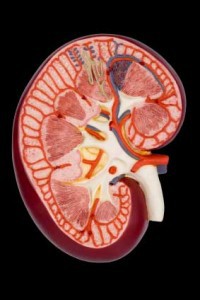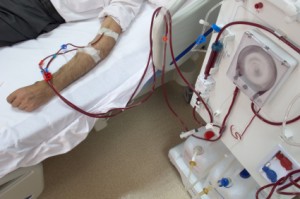A Fresenius Dialysis Machine is a computerized pump used to filter toxins from the body when the kidneys are no longer able to do so. Fresenius offers pumps for both clinical and home use.
Fresenius
History and overview
Fresenius is a medical care company that has been a well-known provider of healthcare resources, information, equipment and services since the 1400s, more recently they have made significant contributions to the world of diabetes.
In 1966 the Fresenius medical company began to manufacture and sell dialysis machines. They have manufactured both peritoneal and hemodialysis products that can be used in clinics and also some that can be used at home.
Today, they are one of the leading markets for dialysis machines and pumps.
There are of course other brands of dialysis machines. Speak to your doctor, case manager, or healthcare team to choose the right fit for you, as other machines or brands may vary in cost, quality or user-friendliness.
Using the Machine:
Your nurse or doctor will explain to you exactly how to use the machine if you plan to use it at home. There are helpful youtube tutorials and user guides available on the internet as well, but the most helpful will be to learn in person, with the machine, and with the guidance of an expert.
Anatomy and Physiology: The Renal and Urinary System
Most people are born with two, healthy functioning kidneys. The kidney, part of the urinary system, is an organ located in the body’s midsection on either side of the spine. There is one kidney on both the left and right side of your body.
 Its name is representative of its shape, as the shape has been described as having the same shape as a kidney bean. However, unlike a kidney bean, on the inside of the kidney organ is a complex filtration system that serves to remove toxins from the bloodstream and eliminate them from the body in the form of urine.
Its name is representative of its shape, as the shape has been described as having the same shape as a kidney bean. However, unlike a kidney bean, on the inside of the kidney organ is a complex filtration system that serves to remove toxins from the bloodstream and eliminate them from the body in the form of urine.
So, the kidney on one end receives blood, and the blood travels through the many filters of the kidney. As blood passes through each level of filtration it becomes clean and returns to give oxygen and energy to other organs in the body. This filtration system also helps to regulate the amount of sodium and potassium in your body; secretes a hormone that signals the body to make more red blood cells; as well as maintains blood pressure.
Finally, the toxins that are filtered out of this blood are removed from the body as urine. The urine leaves the kidney (with its waste) through tubes called ureters that open into the bladder. Then, as the bladder fills, urine is released from the body through another small tube called the urethra.
Pathophysiology: Renal Dysfunction or Failure
Sometimes, if there is a sudden or repeated lack of blood flow to the kidneys, this set of power organs will become damaged, injured, or stop working and no longer carry out their functions. This can be due to a variety of factors such as:
- Severe dehydration
- Chronic illnesses (like diabetes or chronic high blood pressure)
- Certain acute illnesses (like a heart attack, severe burn, or severe allergic reaction)
- Severe kidney infection (or other severe infections like sepsis)
- Trauma to the kidney (for example, the kidney is physically damaged to do an auto accident)
- Exposure, use or overuse of toxins (environmental, illegal drugs, anti-inflammatory medications)
When the kidneys are no longer able to carry out their function the whole body suffers.
Symptoms of kidney failure
Symptoms of kidney failure or low kidney function may include, but aren’t limited to the following:
- Fatigue
- Confusion
- Low urinary output
- Edema (swelling) of lower extremities
- Shortness of breath, pressure in the chest
- Severe symptoms: seizure or coma
Treatment
The function of the kidney is necessary to survive. Fortunately, many people can survive with only one kidney, and some people can survive with one kidney that isn’t even functioning at 100%.
For people who find themselves facing kidney damage, dysfunction or failure, there are a couple of treatment options:
- Kidney transplant
- Dialysis
Talk to your nephrologist about what treatment options are right for you.
Kidney transplant
Simply stated, a person in need of a kidney can request a transplant under the advice of their healthcare team. A donor organ is sought and if there is a match, it is harvested from the donor and surgically implanted into the recipient.
Dialysis
Dialysis is a treatment that is used, normally with a computerized machine, to mimic the functions of a kidney when the kidney itself is no longer able to do so.
There are two main types of dialysis: peritoneal and hemodialysis.
Peritoneal Dialysis
Peritoneal dialysis is normally done by the patient themselves. In this case, the peritoneum (or lining of the abdomen) filters the blood. A catheter is placed near the patient’s belly button (navel) and remains there for as long as treatment is needed. The patient then is instructed on how to administer a special solution through this catheter, wait for the filtration exchange to happen, and then remove the solution into a separate bag afterward.
Hemodialysis
Hemodialysis requires the help of a machine. Basically, a two-way port system is placed into a patient’s arm. Blood is pumped out of their body into a machine; the machine filters the blood (just like the kidney); and then returns it through the other side of the port, back into the body. This type of dialysis is normally done as an outpatient procedure in a clinic, but also can be done at home under the right conditions.
How long does hemodialysis take? How many times per week?
Hemodialysis often requires three visits weekly to a clinic. Each treatment session lasts between three and five hours.
If you are able to do hemodialysis treatments at home, the schedule may be a bit different. Home treatments are usually done six-seven times per week and last only two to three hours.
How much does dialysis treatment cost?
Dialysis treatment can be very expensive, of course depending on your specific circumstance a conversation with your doctor and perhaps a financial advisor can help you and your family to make the best decision.
Does it hurt?
Dialysis treatment should not be painful (if it is, tell your doctor or nurse immediately), although some side effects may be experienced. Side effects of dialysis may include:
- Nausea and/or vomiting
- Dry skin
- Muscle cramping
- Fatigue
Do I need a port?
Yes, everyone who needs hemodialysis needs to have an open access to their bloodstream. There are however some options for this that can be chosen with your doctor’s help to choose the most appropriate for your lifestyle.
- Central Venous Catheter
- Fistula
- Graft
Fistula:
A fistula requires a minor surgery where an artery (takes blood away from the heart) and a vein (takes blood back to the heart) are ‘fused’ together. These fistulas are under the skin and usually placed in the non-dominant arm (the arm you don’t write with). Fistulas are considered more permanent, as they can be used for dialysis treatment for many years without the need for replacement.
Graft:
Similarly to the fistula, a graft also joins an artery and a vein. A graft however uses a plastic tube to join the artery and the vein. A graft requires less healing time than a fistula but is less permanent. They usually last a few years but will need to be replaced. Additionally, grafts can be more prone to infection than fistulas.
Central Venous Catheter:
This is a very temporary option, as a small tube is placed into a large vein (such as a vein in your neck, collarbone area or groin) and then removed after the treatment. This is most often used when a dialysis treatment is needed quickly and there hasn’t been time to allow for a surgical procedure and recovery time to place a more permanent port.
Coping with dialysis
Whether you have been dealing with dialysis for many years, recently received a diagnosis, or are helping someone else, you can be sure to feel a variety of emotions. Feelings of depression, guilt, anger and a loss of control can be common. Remember that you are not alone!
Please consider setting up a regular meeting with a professional to talk about these difficult feelings and emotions.
Life-giving tips for dialysis treatment
People undergoing dialysis treatment will spend many hours sitting or resting during their treatment, the following list may provide you with some ideas to occupy your time in a healthy way!

- Read books
- Take an online class
- Bring a friend or family member with you and use the time to get to know each other better
- Consider having your treatments done at night time and sleep through them
- Listen to recorded books or podcasts
- Practice meditation or mindfulness
- Keep a spirit of gratitude and stay positive